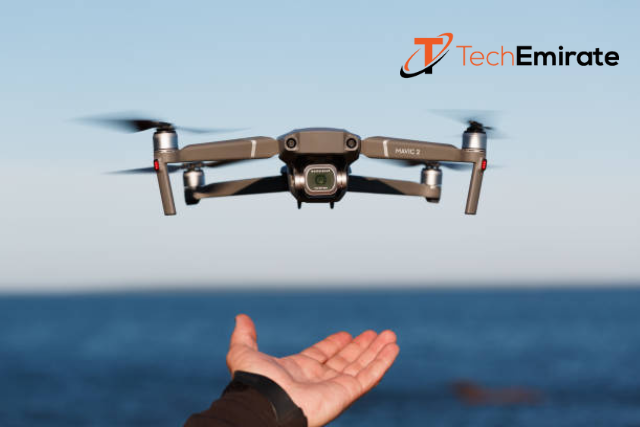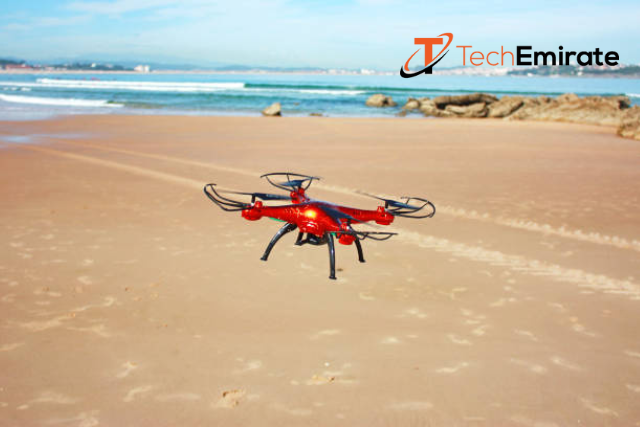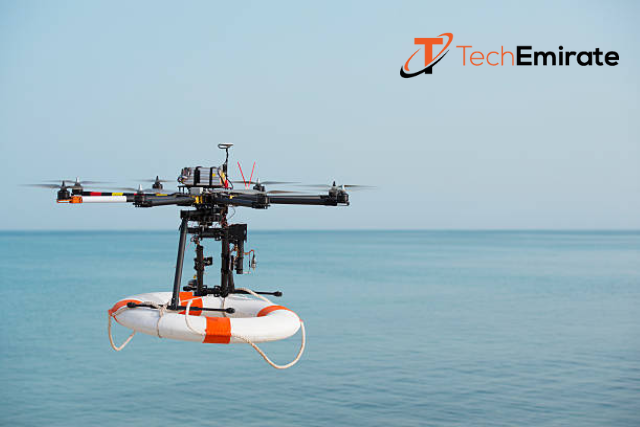Breathtaking aerial shots of beaches, surfers, and water sports enthusiasts have captivated many audiences. Can you fly a drone across the ocean to capture these exhilarating moments? Drones, in particular, are gaining immense popularity among these groups due to their ability to capture action from unique perspectives.
But, it’s important to note that there are certain rules you must adhere to regarding drone flights at your particular ocean or beach. These rules might be implicit or established by the local governing body overseeing the beach.
Table of Contents
Can You Fly a Drone Across the Ocean

The journey of flying drones over the ocean is a thrilling proposition that stirs the imagination. “Can you fly a drone across the ocean?” The question itself echoes with a sense of adventure.
But before I let my drone take flight across the vast expanse of water, there are essential considerations to navigate.
Legal Considerations
Can You Fly a Drone on the Beach in California and Florida? The golden coasts of California and the sunshine state of Florida beckon drone enthusiasts. But as we set our sights on capturing breathtaking aerial views, we must also respect the regulatory framework in place. Navigating the specifics of where and when you can fly your drone is crucial for a hassle-free experience.
Legal Height Limits for Flying Drones
So, how far can your drone soar legally? Understanding the legal altitude limits ensures compliance with aviation regulations. Most guidelines recommend staying below 400 feet, striking a balance between exploration and safety.
Mandatory Insurance for Drone Flying
Insurance is not just a safety net; it’s a prerequisite for responsible drone ownership. Accidents happen, and having the right coverage ensures you’re financially protected. Let’s explore the why, when, and how of drone insurance, safeguarding both your investment and peace of mind.
10 Tips for Flying Your Drone Safely Over Water

Flying a drone over water can be a great way to get stunning aerial shots, but it’s important to do so safely and responsibly. Here are 10 tips to help you fly your drone safely over water:
- Check the airspace. Before you fly, make sure to check the airspace for any restrictions. You can do this using a number of online resources, such as the FAA’s DroneZone app.
- Fly within your visual line of sight (VLOS). This means that you should always be able to see your drone with your own eyes. Never fly beyond your VLOS, even if you are using a first-person view (FPV) camera or underwater photography camera.
- Be aware of the wind. Wind can make it difficult to control your drone, especially over water. Avoid flying in strong winds, and be prepared to land your drone if the wind conditions become too challenging.
- Take off and land from a safe location. Don’t take off or land your drone from the water. Instead, find a safe, dry location to take off and land from.
- Use a return-to-home (RTH) function. Many drones have an RTH function that will automatically return the drone to its home point if it loses signal or runs low on battery power. This can be a lifesaver if your drone gets into trouble over water.
- Be aware of other boats and swimmers. Keep an eye out for other boats and swimmers when flying your drone over water. If you see someone in the water, make sure to fly your drone at a safe distance.
- Don’t fly too close to the water. Water can be very damaging to drones. If your drone falls into the water, it is likely to be destroyed.
- Be prepared for emergencies. Always have a plan for what you will do if your drone gets into trouble over water. This could include having a boat or kayak nearby that you can use to retrieve your drone.
- Follow local regulations. Be sure to follow all local regulations regarding drone usage. These regulations may vary from place to place.
- Fly responsibly. Always fly your drone in a safe and responsible manner. Be aware of your surroundings and take all necessary precautions to avoid accidents.
Can You Fly a Drone at the Beach?

Usually, it’s okay, but the rules can be different depending on where you are. People love using drones to get cool pictures at the beach, especially surfers and water fans. Some beaches let you fly drones however you want, but others might have rules, either official or just understood.
Before you start flying, it’s important to check and follow any specific rules for using drones at your chosen beach. Respecting privacy, being safe, and following the local rules will help everyone have a good time at the beach with their drones.
Factors to keep in mind when flying a drone at the beach
It’s crucial to consider various factors to ensure safe and responsible drone operation in this environment. Here are some key points to keep in mind:
Local Regulations and Airspace Restrictions
- Local Regulations
Before flying your drone, check with the local authorities or beach management to understand any specific regulations or restrictions on drone usage in the area. Some beaches may have complete bans on drones, while others may allow them only in designated zones or under specific conditions.
- Airspace Restrictions
Consult airspace maps or online resources like the FAA’s DroneZone app to identify any controlled airspace in the vicinity of the beach. Flying drones in controlled airspace without proper authorization is strictly prohibited.
2. Weather Conditions
- Wind
Strong winds can make controlling a drone challenging, especially over water. Avoid flying in gusty or windy conditions to maintain stability and control.
- Precipitation
Rain, snow, or other forms of precipitation can damage the drone’s electronics and potentially lead to malfunctions. Avoid flying in adverse weather conditions to protect your drone and maintain safe operation.
3. Respecting Other Beachgoers and Wildlife
- Public Safety
Focus on the safety of other beachgoers. Avoid flying over crowds or close to swimmers, sunbathers, or other individuals. Maintain a safe distance and respect their personal space.
- Wildlife Protection
Be mindful of wildlife, especially nesting birds or areas where wildlife congregates. Avoid flying near sensitive habitats or disturbing wildlife populations.
4. Property Rights and Privacy:
- Private Property
Do not fly your drone over private property without explicit permission from the landowner or property manager. Respect property boundaries and avoid trespassing or invading privacy.
- Photography and Privacy
Be cautious when capturing images or videos of individuals without their consent. Respect privacy and avoid filming or photographing people without their knowledge or agreement.
5. Responsible Drone Operation
- Visual Line of Sight (VLOS)
Always maintain VLOS with your drone, ensuring you can see it clearly and directly at all times. This is crucial for maintaining control and situational awareness.
- Return-to-Home (RTH) Function
Familiarize yourself with the RTH feature on your drone. This function automatically returns the drone to its home point in case of signal loss or critical battery conditions.
- Emergency Procedures
Have a plan for emergency situations, such as retrieving a drone that falls into the water. Consider having a boat or kayak nearby to assist in recovery efforts.
- Adherence to Local Laws
Comply with all local ordinances and regulations governing drone usage in the specific area. These regulations may vary from one location to another.
- Responsible Flying Practices:
Operate your drone responsibly, prioritizing safety and respecting the environment and others. Avoid reckless flying or maneuvers that could endanger others or cause disruptions.
FAQs About Can You Fly a Drone Across the Ocean
Here are 9 FAQs about Can you fly a drone across the ocean:
Can a drone fly over the ocean?
Yes, drones can fly over the ocean, but it is important to take some precautions to ensure a safe flight. The biggest risk of flying a drone over water is that the drone could fall into the water and be damaged or destroyed.
To minimize this risk, it is important to fly the drone at a high altitude and to avoid flying in windy or stormy conditions. It is also a good idea to have a plan for recovering the drone if it does fall into the water.
Are you allowed to fly a drone off a cruise ship?
The answer to this question depends on the cruise line and the specific ship. Some cruise lines have policies that prohibit drone flying on their ships, while others allow it under certain conditions. It is always best to check with the cruise line before attempting to fly a drone on board.
Can drones work under the sea water?
No, drones are not designed to work underwater. The water pressure and salt water would damage the drone’s electronics. However, there are some underwater drones that are specifically designed for underwater use. These drones are typically used for scientific research or military applications.
Can you land a drone on water?
No, drones are not designed to land on water. The water would damage the drone’s propellers and landing gear. However, there are some amphibious drones that can land on both land and water. These drones are typically used for search and rescue operations or other applications where landing on water is necessary.
Should you fly drone over water?
Flying a drone over water is not necessarily dangerous, but it is important to take precautions to minimize the risk of an accident. If you do decide to fly a drone over water, be sure to follow these safety tips:
- Fly at a safe altitude. This will reduce the risk of the drone falling into the water.
- Avoid flying in windy or stormy conditions. Wind and rain can make it difficult to control the drone and increase the risk of an accident.
- Be aware of your surroundings. Watch out for other boats, swimmers, and wildlife
- Have a plan for recovering the drone if it does fall into the water.
What to do if DJI drone falls in water?
If your DJI drone falls into the water, the first thing you should do is to turn it off immediately. This will prevent the drone from short-circuiting and further damage. You should then remove the battery from the drone. Once the battery is removed, you can attempt to dry the drone out. If the drone is not too badly damaged, it may still be possible to repair it.
Can you fly a drone at myrtle beach?
Yes, you can fly a drone at Myrtle Beach, but there are some restrictions. The Federal Aviation Administration (FAA) has established a Temporary Flight Restriction (TFR) over Myrtle Beach. This means that you must obtain a waiver from the FAA before flying a drone in the TFR. You can apply for a waiver on the FAA’s website.
What is the legal height limit for flying a drone or model aircraft?
The legal height limit for flying a drone or model aircraft in the United States is 400 feet above ground level (AGL). However, there are some exceptions to this rule. For example, you can fly a drone higher than 400 feet AGL if you have obtained a waiver from the FAA. You can also fly a drone higher than 400 feet AGL if you are flying in a controlled airspace and have obtained permission from the air traffic control authority.
When must you always have insurance for flying your drone or model aircraft?
You are required to have insurance for flying your drone or model aircraft if you are flying it for commercial purposes. This means that you must have insurance if you are using your drone to take photographs or videos that you intend to sell or use for commercial purposes. You are also required to have insurance if you are flying your drone in a controlled airspace.
Summing Up
In conclusion, the fascination of flying a drone over the ocean is undeniable. This guide covers everything from grasping legal necessities and choosing the right drone to emphasizing safety and interacting with local communities. It provides you with the insights required for a smooth and pleasurable experience.
So, can you fly a drone across the ocean? The answer is yes, but with knowledge, responsibility, and the best water-resistant drone for fishing, your aerial escapades near the ocean can be genuinely extraordinary.”

